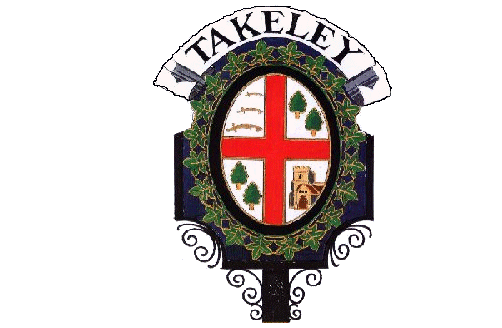|
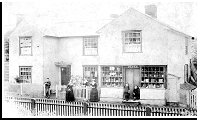
Photograph courtesy of Mike Piper
Guyvers, Brewers End
Guyvers was constructed in the early 1850s by George Piper. It remained in the family until around 1935 (when it was bought by the Newman family) and was finally demolished in the early 1960s to make way for the Cambridge Service Station. During its time Guyvers was a General Store, Post Office, telephone exchange, guest house, builders, garage, petrol station, cycle hire and undertakers.
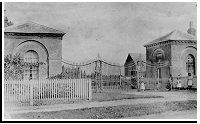
Photograph from Takeley Local History Society Archive
Bassingbourn Hall Gatehouse
These fine gates were the entrance to the grounds of Bassingbourn Hall which was demolished in the early 1990s to make way for Stansted Airport development. The gatehouses can still be seen on the A120 between Kearsley Airways and the Old Mill public house.
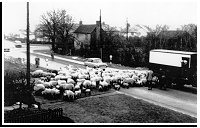
Photograph courtesy of Ray Altham
Sheep In Station Road
It used to be quite normal for farm animals to be driven "on the hoof" on public roads; these sheep and their lambs had been unloaded from a train in 1961 and were being driven to a local farm. Mr. Davis's lorry awaits to resume its journey to the egg packing depot.
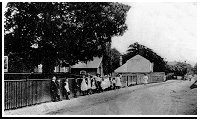
Photograph from Takeley Local History Society Archive
The School, Brewers End
We believe (from the clothes and the absence of kerbstones) that this photograph of Takeley children outside their school on what is now the A120 dates from around the turn of the century. This was a Penny School, 1d per child per week being charged, the exception being tradespeople who were charged 3d.
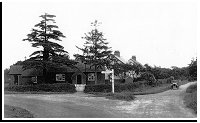
Photograph courtesy of Pat Salmon
The School, Mole Hill Green
This scene of Mole Hill Green School dates from around 1930. The school was built in 1852 and was used as such until 1947. It was subsequently bought by the village and has been used since as a village hall. The trees are now gone and the signpost and letter box have been moved, otherwise the scene is much as it used to be. We assume the old Austin was the photographer's car.
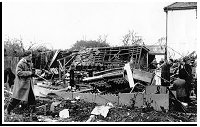
Photograph courtesy of Ray Altham
Telephone Exchange Explosion
On the morning of Wednesday 14th November 1962 Percy Rushen, landlord of the Four Ashes, phoned the gas company to report a particularly strong smell of gas. His call, unfortunately, caused the switching of a relay in the telephone exchange, igniting gas which had built up there. The resulting explosion made national news headlines and caused damage to 50 houses. Miraculously only 6 were injured.
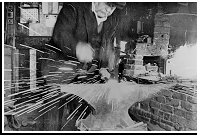
Photograph courtesy of Ron Halls
The Smithy, Mole Hill Green
This photograph dates from the 1960s and shows Fred Halls, the Mole Hill Green village blacksmith. Fred started at the smithy aged 18 in 1926 when it was run by a Mr Cornell. He bought the business in 1950 and was joined on leaving school by his son Ron, who runs the business to this day.
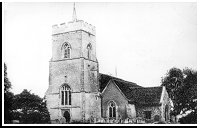
Photograph from Takeley Local History Society Archive
Holy Trinity Church
Close inspection of this early picture of Holy Trinity Church reveals that the spire is not as it appears today. This dates the photograph to pre 1928 when the original wooden spire was struck by lightning and destroyed by fire. The spire was subsequently replaced by one of a different shape.
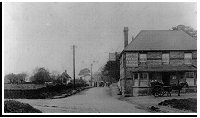
Photograph from Takeley Local History Society Archive
Four Ashes Crossroads
Takeley Four Ashes Public House is probably our best known landmark, standing as it does where Stane Street, the Roman road now the A120 from Bishop's Stortford to Dunmow, crosses the road from Hatfield Broad Oak to Broxted. Although the above scene is easily recognisable it is very different today with the roads considerably widened, traffic lights added and the development of Hawthorn Close.

Photograph courtesy of John Read
Read & Son, Dunmow Road
Read & Son's stores in Dunmow Road was originally run by Ernest Read. In the 1920s Ernest's son Percy Read developed part of it as a cycle repair shop and then a garage. This picture taken around 1928 shows Percy Read (on the right with flat cap) in front of the petrol pumps.
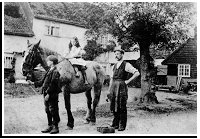
Photograph from Takeley Local History Society Archive
The Smithy, Brewers End
The Brewers End smithy (with the house Attridges) can still be seen today although it has not been used as a smithy since the late 1920s. The last smith, Frank Barltrop, is pictured here with his daughter Isabel and son Lawrence. Attridges was a beer house known as "The One Ash" and was the Post Office up until 1972. It was also Dr. Bennison's surgery during the 1950s and 1960s.
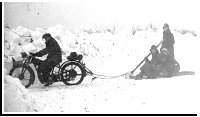
Photograph courtesy of Pat Salmon
Snow in Parsonage Road
For those of us convinced that global warming is already affecting our weather and that winters of old were more severe, here is a scene from Parsonage Road in 1927. We believe the motor cyclist is Fred Salmon.
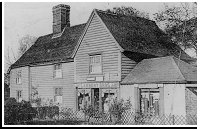
Photograph from Takeley Local History Society Archive
Chestnuts, Brewers End
The Brewers End Post Office has occupied many sites. In the1850s it was in Guyvers (owned by the Piper family) before crossing the road to Chestnuts (owned by the Lambert family). It then crossed the road once more to Attridges, next to the smithy, both owned by the Barltrop family. Chestnuts went on to become a guest house, cafe and antique shop and is now office accommodation.

|
